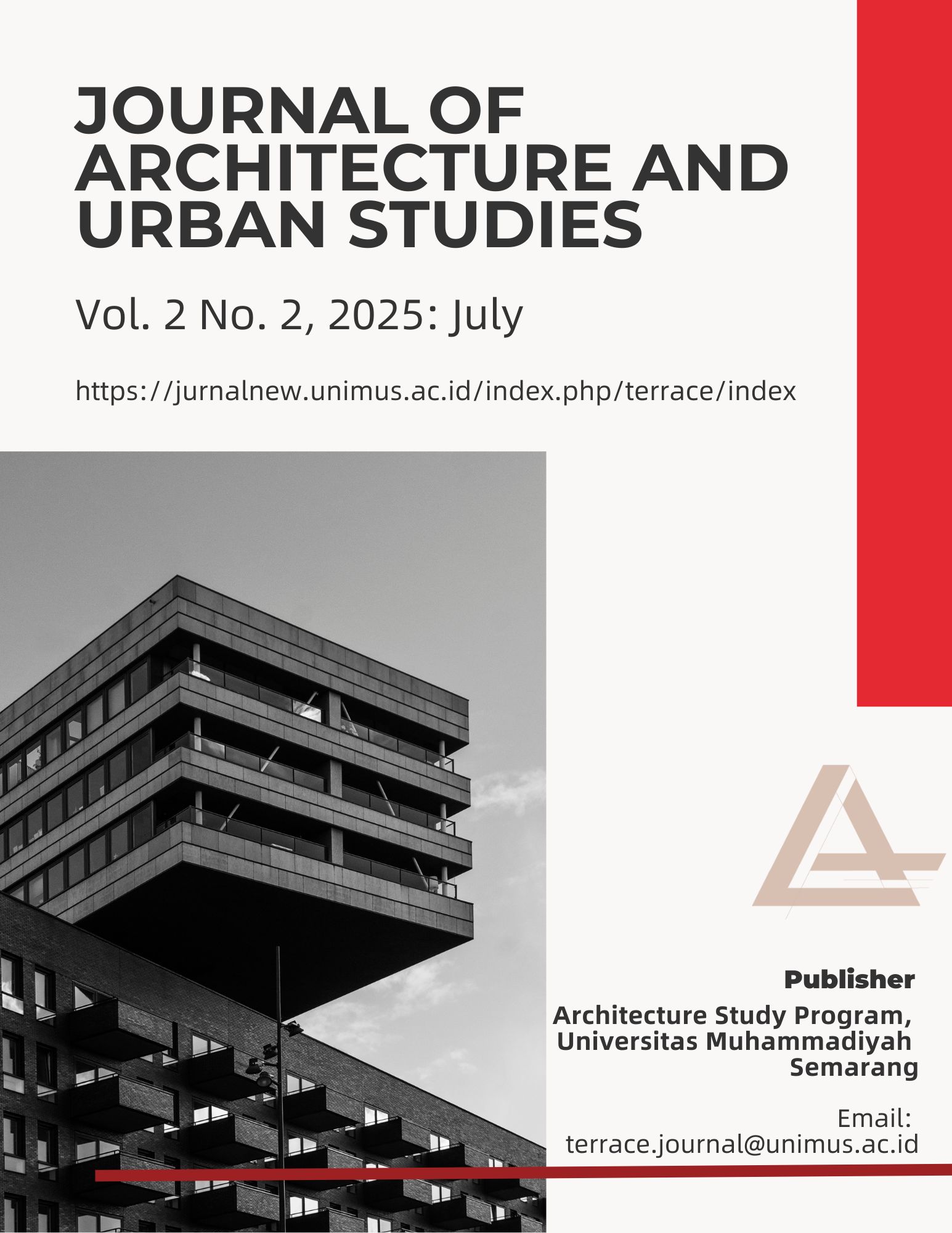Green Retrofitting of Cultural Heritage Building: A Case Study of Banten Grand Mosque
Keywords:
green retrofitting, cultural heritage, thermal comfort, Banten Grand Mosque, adaptive conservationAbstract
The Banten Grand Mosque, as one of Indonesia’s oldest cultural heritage buildings, is more than just a place of worship; it embodies layers of history, identity, and spiritual significance for the local community. However, in the face of climate change and rising expectations for user comfort, the mosque is challenged to maintain a balance between thermal performance and architectural authenticity. This study aims to explore passive-based green retrofitting strategies that are both environmentally responsive and sensitive to conservation principles. Research was conducted through field observations, documentation, stakeholder interviews, and a review of relevant literature on green building and heritage conservation. The results highlight several thermal comfort problems, including limited cross ventilation, inadequate roof insulation, and high indoor humidity due to the hot-humid tropical climate. These conditions often cause discomfort for worshippers, particularly during peak hours of use. To address these challenges, the study proposes adaptive yet reversible interventions, such as optimizing natural ventilation through additional lattice panels, applying eco-friendly reflective paints, using natural insulation materials like coconut fiber, and introducing vegetation to enhance microclimate quality. These strategies emphasize the principle of non-invasiveness, ensuring that any modification can be removed without damaging the original structure. Through this approach, the Banten Grand Mosque has the potential to remain a living heritage site: conserving its historical and architectural identity while adapting to contemporary needs of energy efficiency and user comfort. The findings not only provide recommendations for this mosque but also contribute to the discourse on sustainable conservation of tropical heritage buildings.
References
W. Kurniawati and K. D. Astuti, “Bentuk Ketahanan Iklim Kawasan Bersejarah di Kampung Melayu Semarang,” Ruang, vol. 1, no. 2, pp. 251–260, 2013.
V. Anggit Pramudya and D. I. Wibisono, “Strategi Pendinginan Pasif Pada Gedung Seni Taman Balekambang di Surakarta.”
Pemerintah Republik Indonesia, Undang-undang Nomor 11 Tahun 2011 tentang Perubahan atas Undang-undang Nomor 10 Tahun 2010 tentang APBN Tahun Anggaran 2011. Indonesia: Lembaran Negara RI Tahun 2011 Nomor 81; Tambahan Lembaran Negara Nomor 5233; 35 hlm, 2011.
J. Prasetya and S. Handoko, “Penerapan Strategi Pendinginan Pasif pada Bangunan Masjid Pathok Negoro di Yogyakarta,” 2024. [Online]. Available: https://id.wikipedia.org,
A. Kriswandhono and Nurtjahja Eka Pradana, Sejarah dan Prinsip Konservasi Arsitektur Bangunan Cagar Budaya Kolonial. Semarang: Program Studi Arsitektur dan Desain Universitas Katolik Soegijapranata, 2010.
D. Lamsal, V. Sreeram, Y. Mishra, and D. Kumar, “Output power smoothing control approaches for wind and photovoltaic generation systems: A review,” Renewable and Sustainable Energy Reviews, vol. 113, p. 109245, 2019, doi: https://doi.org/10.1016/j.rser.2019.109245.
A. Weningtyas Handoyono and dan Agung Murti Nugroho, “STRATEGI DESAIN PASIF UNTUK PENDINGINAN ALAMI PADA RUMAH VERNAKULAR JAWA (Studi Kasus: Omah Joglo Karangnongko).”
D. Kajjoba, R. Wesonga, J. D. Lwanyaga, H. Kasedde, P. W. Olupot, and J. B. Kirabira, “Assessment of thermal comfort and its potential for energy efficiency in low-income tropical buildings: a review,” Sustainable Energy Research, vol. 12, no. 1, May 2025, doi: 10.1186/s40807-025-00169-9.
“ANSI/ASHRAE Addendum d to ANSI/ASHRAE Standard 55-2017,” 2020. [Online]. Available: www.ashrae.org
F. T. B. Samodra, S. N. N. Ekasiwi, I. G. N. Antaryama, I. Defiana, and E. Sudarma, “Evaluasi Adaptasi Kondisi Termal Gereja Cagar Budaya di Lingkungan Tropis Perkotaan (Studi Kasus: GPIB Immanuel Kota Malang),” Sewagati, vol. 8, no. 3, pp. 1729–1740, Jun. 2024, doi: 10.12962/j26139960.v8i3.1028.
I. P. Misbach, M. Bakri, and D. A. Sumarto, “KONSEP OPTIMALISASI KENYAMANAN TERMAL PADA PERANCANGAN PUSAT PELATIHAN BAHASA ASING DI BANDA ACEH,” Jurnal Arsitektur ARCADE, vol. 6, no. 1, p. 115, Apr. 2022, doi: 10.31848/arcade.v6i1.825.
N. A. Azmi, A. Baharun, M. Arıcı, and S. H. Ibrahim, “Improving thermal comfort in mosques of hot-humid climates through passive and low-energy design strategies,” Frontiers of Architectural Research, vol. 12, no. 2, pp. 361–385, Apr. 2023, doi: 10.1016/j.foar.2022.07.001.
N. Soewarno, M. R. Musadi, and A. P. Sulistiawan, “Simulation of Thermal Comfort of Heritage Residential House in Bandung using Computational Fluid Dynamic.”
H. S. S. Ibrahim, A. Z. Khan, W. A. Mahar, S. Attia, and Y. Serag, “Assessment of passive retrofitting scenarios in heritage residential buildings in hot, dry climates,” Energies (Basel), vol. 14, no. 11, Jun. 2021, doi: 10.3390/en14113359.
A. O. Shehata, A. M. Hassan, M. M. Shahda, and N. A. Megahed, “Green retrofitting of heritage buildings based on (3Ts) framework: An applied case study,” Frontiers of Architectural Research, vol. 13, no. 4, pp. 776–798, 2024, doi: https://doi.org/10.1016/j.foar.2024.02.015.
Downloads
Published
How to Cite
Issue
Section
License
Copyright (c) 2025 Journal of Architecture and Urban Studies

This work is licensed under a Creative Commons Attribution-NonCommercial 4.0 International License.












